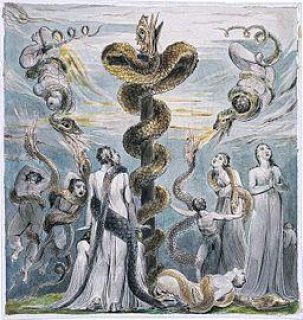Progressive reflections on the lectionary #7
Monday 11th March 2024
John 3: 14-21

This week’s gospel passage contains one of the most famous lines in the New Testament - one which is frequently held up as ‘the gospel in miniature’ - a bit like the way the Isle of Arran is sometimes described as ‘Scotland in miniature’. In both cases, the statement is something of an oversimplification.
Rather than beginning with a focus on the sixteenth verse, let’s look instead at the fourteenth, because there’s something that goes largely ignored there. “…just as Moses lifted up the serpent in the wilderness…” the verse begins, which whisks us back to the Old Testament, the Hebrew Scriptures, and in particular to the book of Numbers - which, ironically, has lots of words in it.
The story of Moses and the serpent on the pole is in Numbers 21: 4-9. TLDR: while in the wilderness people get fed up, so God gets cross and sends ‘serpents’ to bite them (fatally), and they don’t like it. Rather than taking the ‘serpents’ away, God tells Moses to make a model serpent out of brass and pop it on a pole so that when people look at it they will be healed. Just another story of the peculiarity and violence of divine logic, (and the apparent handiness of always carrying a lump of brass and an an anvil while trekking through the wilderness).
I’m not usually a fan of the King James Version, except for it’s poetic qualities. But the KJV has an advantage over many more contemporary (and reliable) versions, because it makes an important distinction. Where other versions talk about ‘serpents’, the KJV speaks of ‘fiery serpents’. Why? Because these serpents weren’t any old snakes.
In her excellent book ‘God’s Monsters’ Esther Hamori, a Bible scholar or some reputation, explores the various monstrous creatures that God can call upon, according to the ancient texts. Among them are the ‘Seraphim’ - a word we’re used to thinking of as a nice little angel figure, but originally refers to God’s fiery attack snakes. What God tells Moses to make out of metal is a model of a ‘Seraph’, because the ‘serpents’ were God’s monsters.
Note: Staffs, or poles, with snakes on them are common to many cultures. Among them, the ever reliable Mesopotamians who had a snake deity with magical powers. The Greeks loved that sort of thing too. Snake amulets and other icons were carried and used as grave goods by all sorts of people. Basically, where uncertainties exist (like the danger of being bitten by a snake) rituals and totemic artefacts abound. This is not necessarily a bad thing, but it’s something that’s worth recognising.
Our story moves on, and eventually, centuries later, the people who had wandered (and wondered) in the wilderness get settled. Time passes. Eventually we reach the time of Hezekiah, son of King Ahaz, and by then the serpent on a pole has taken on a new role. Despite, or perhaps because of, its weird origin story, it is now an object of direct veneration, it has become an idol to which people burned incense. Someone named it ‘Nehushtan’. It was, effectively, a god in its own right. So in 2 Kings 18 we read that Hezekiah took it upon himself to smash Nehushtan up along with all the other idols.
How easily we make idols. How ready we are to set up snakes on a pole. Sometimes they are people, sometimes they are Bible verses, very often they are ideas - particularly simplified ones. Sometimes people make the Bible into an idol, endowing it with powers it never claims for itself. As soon as something, anything, becomes an object of veneration, something about which we stop asking the difficult questions, about which we suspend enquiry, we need to be careful in case we have created another monster, one which may need to be smashed.
This blog is taken from Simon's Substack email series, to subscribe please go to https://simonjcross.substack.c...
Image: William Blake., Public domain, via Wikimedia Commons


Comments